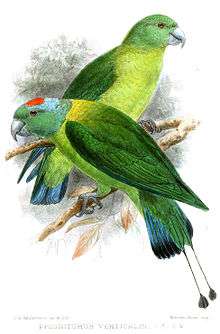Blue-winged racket-tail
The blue-winged racket-tail or Sulu racquet-tail (Prioniturus verticalis) is a species of parrot in the family Psittaculidae. It is endemic to Tawi-Tawi island in the Philippines.
| Blue-winged racket-tail | |
|---|---|
 | |
| Scientific classification | |
| Kingdom: | Animalia |
| Phylum: | Chordata |
| Class: | Aves |
| Order: | Psittaciformes |
| Family: | Psittaculidae |
| Genus: | Prioniturus |
| Species: | P. verticalis |
| Binomial name | |
| Prioniturus verticalis Sharpe, 1893 | |
Description
Prioniturus verticalis has mainly dark green plumage on back, an olive/green on its breast and belly. Male birds have a pale blue with small red patch on its forehead and forecrown. Females look identical to the male except, they do not have a red spot on their forecrown. The primary feathers blue on outer webs while the middle tail feathers green. Racquet feathers black tinged with blue. Their side tail feathers are green tipped black. Their bill has a blue-grey hue.
Range and description
Once prevalent throughout all the islands of the Sulu Archipelago, the blue-winged racket-tail is now only found on isolated places on Tawi-Tawi due to rapid habitat destruction during the past 200 years.
Habitat
Its natural habitats are subtropical or tropical moist lowland forests and subtropical or tropical mangrove forests. It is threatened by habitat loss.
Ecology and behavior
Prioniturus verticalis is a rather tame bird and does not usually fear human presence (which has also led to its critically endangered status). They are usually seen in pairs flying over and in the high canopy of trees. It is also rather noisy in flight. This bird feeds on the fruit and flowers of fruiting trees.
Threats
One of this bird's threats is its own tame behavior. This tame behavior is taken advantage of by trappers and has made it an easy target to capture for the illegal exotic pet trade. Deforestation of the blue-winged racket-tail's natural habitat to make way for agriculture, mining, and the uncontrolled settlement by humans has destroyed most of this bird's original habitat. Only a small population of 50-249 birds now remain on Tiwi-Tiwi (and the world).
References
- BirdLife International (2012). "Prioniturus verticalis". IUCN Red List of Threatened Species. 2012. Retrieved 26 November 2013.CS1 maint: ref=harv (link)
External links
- BirdLife Species Factsheet.
- Oriental Bird Images: Blue-winged Racquet-tail
- "Blue-winged Racquet-tailed Parrot (Prioniturus verticalis) | Parrot Encyclopedia". parrots.org. Retrieved 12 November 2016.
